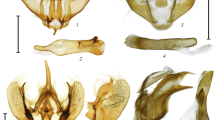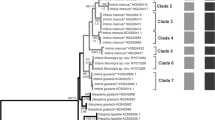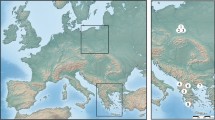Abstract
Macaria mirthae Vargas et al (Lepidoptera: Geometridae) is a geometrid moth native to the northern Atacama Desert of Chile. Its oligophagous larvae are associated with native hosts of the plant family Fabaceae, the most important of which is Acacia macracantha. The invasive tree Leucaena leucocephala (Fabaceae) was recently recorded as a host plant for M. mirthae based on morphology. The taxonomic status of larvae collected on A. macracantha and L. leucocephala was assessed using sequences of the DNA barcode fragment of the cytochrome c oxidase subunit I (COI) gene. Genetic divergence between samples from the host plants was found to be 0%–0.8% (Kimura 2-parameter model). Neighbor-joining and maximum likelihood analyses were also performed, including additional barcode sequences of Neotropical geometrid moths from GenBank and BOLD databases. Sequences of the larvae from both host plants clustered in a single clade with high statistical support in both analyses. Based on these results, it is concluded that M. mirthae has effectively expanded its host range and its larvae are currently feeding on the exotic tree L. leucocephala. Additionally, the importance of this new host association in a highly disturbed habitat is briefly discussed in terms of the field biology of this native geometrid moth.


Similar content being viewed by others
References
Atashpaz S, Khani S, Barzegari A, Barar J, Vahed SZ, Azarbaijani R, Omidi Y (2010) A robust universal method for extraction of genomic DNA from bacterial species. Microbiology 79:538–542
Bandelt HJ, Forster P, Röhl A (1999) Median-joining networks for inferring intraspecific phylogenies. Mol Biol Evol 16:37–48
Benson DA, Cavanaugh M, Clark K, Karsch-Mizrachi I, Lipman DJ, Ostell J, Sayers EW (2013) GenBank. Nucleic Acids Res 41:D36–D42
Bowers MD, Richardson LL (2013) Use of two oviposition plants in populations of Euphydryas phaeton Drury (Nymphalidae). J Lepid Soc 67:299–300
Bowers MD, Schmitt J (2013) Overcrowding leads to lethal oviposition mistakes in the Baltimore checkerspot, Euphydryas phaeton Drury (Nymphalidae). J Lepid Soc 67:227–229
Costa JNM, Durigan G (2010) Leucaena leucocephala (Lam.) de Wit (Fabaceae): invasora ou ruderal? Rev Árvore 34:825–833
Dincă V, Zakharov EV, Hebert PDN, Vila R (2011) Complete DNA barcode reference library for a country’s butterfly fauna reveals high performance for temperate Europe. Proc R Soc B 278:347–355
Edgar RC (2004) MUSCLE: multiple sequence alignment with high accuracy and high throughput. Nucleic Acids Res 32:1792–1797
Felsenstein J (1981) Evolutionary trees from DNA sequences: a maximum likelihood approach. J Mol Evol 17:368–376
Felsenstein J (1985) Confidence limits on phylogenies: an approach using the bootstrap. Evolution 39:783–791
Forister ML, Scholl CF (2012) Use of an exotic host plant affects mate choice in an insect herbivore. Am Nat 179:805–810
Forister ML, Nice CC, Fordyce JA, Gompert Z (2009) Host range evolution is not driven by the optimization of larval performance: the case of Lycaeides melissa (Lepidoptera: Lycaenidae) and the colonization of alfalfa. Oecologia 160:551–561
Fraser SM, Lawton JH (1994) Host range expansion by British moths onto introduced conifers. Ecol Entomol 19:127–137
Giraldo CE, Uribe SI (2012) Taxonomy of Mechanitis (F.) (Lepidoptera: Nymphalidae) from the West Colombian Andes: an integrative approach. Neotrop Entomol 41:472–484
Global Invasive Species Database (2014) Leucaena leucocephala. http://www.issg.org/database/species/ecology.asp?si=23&fr=1&sts=&lang=EN. Accessed 7 Jan 2014
Gossner MM, Hausmann A (2009) DNA barcoding enables the identification of caterpillars feeding on native and alien oak (Lepidoptera: Geometridae). Mitt Munch Entomol Ges 99:135–140
Graves SD, Shapiro AM (2003) Exotics as host plants of the California butterfly fauna. Biol Conserv 110:413–433
Grishin NV, Burns JM, Janzen DH, Hallwachs W, Hajibabaei M (2013) Oxynetra: facies and DNA barcodes point to a new species from Costa Rica (Hesperiidae: Pyrginae: Pyrrhopygini). J Lepid Soc 67:1–14
Hall BG (2013) Building phylogenetic trees from molecular data with MEGA. Mol Biol Evol 30:1229–1235
Hausmann A, Huemer P (2011) Taxonomic decision as a compromise: Acasis appensata (Eversmann, 1832) in Central Italy—a case of conflicting evidence between DNA barcode and morphology (Lepidoptera: Geometridae). Zootaxa 3070:60–68
Hausmann A, Haszprunar G, Hebert PDN (2011) DNA barcoding the geometrid fauna of Bavaria (Lepidoptera): successes, surprises and questions. PLoS ONE 6(2):e17134. doi:10.1371/journal.pone.0017134
Hebert PDN, Cywinska A, Ball SL, deWaard JR (2003a) Biological identifications through DNA barcodes. Proc Biol Sci 270:313–321
Hebert PDN, Ratnasingham S, deWaard JR (2003b) Barcoding animal life: cytochrome c oxidase subunit 1 divergences among closely related species. Proc Biol Sci 270:S96–S99
Hebert PDN, Penton EH, Burns JM, Janzen DH, Hallwachs W (2004) Ten species in one: DNA barcoding reveals cryptic species in the neotropical skipper butterfly Astraptes fulgerator. Proc Natl Acad Sci U S A 101:14812–14817
Huemer P, Karsholt O, Mutanen M (2014) DNA barcoding as a screening tool for cryptic diversity: an example from Caryocolum, with description of a new species (Lepidoptera, Gelechiidae). ZooKeys 404:91–111
Jaeger CM, Dombroskie JJ, Sperling FAH (2013) Delimitation of Phaneta tarandana (Möschler 1874) and P. montanana (Walsingham 1884) (Tortricidae: Olethreutinae) in western Canada using morphology and DNA. J Lepid Soc 67:253–262
Kimura M (1980) A simple method for estimating evolutionary rate of base substitutions through comparative studies of nucleotide sequences. J Mol Evol 16:111–120
Kruse JJ, Powell JA (2014) Defining Clepsis penetralis Razowski (Tortricidae) using morphology and molecules: a widespread but overlooked North American species. J Lepid Soc 68:25–30
Landry J-F, Hebert PDN (2013) Plutella australiana (Lepidoptera, Plutellidae), an overlooked diamondback moth revealed by DNA barcodes. ZooKeys 327:43–63
Li J-F, Li L, Sheen J (2010) Protocol: a rapid and economical procedure for purification of plasmid or plant DNA with diverse applications in plant biology. Plant Methods 6:1. doi:10.1186/1746-4811-6-1
Librado P, Rozas J (2009) DnaSP v5: a software for comprehensive analysis of DNA polymorphism data. Bioinformatics 25:1451–1452
Lourenção AL, Rezende JAM, Mascarenhas HAA, Ferreira Filho AWP (1980) Ocorrência de Semiothisa abydata (Guenée) (Lepidoptera: Geometridae) em soja no Estado de São Paulo. Bragantia 39:247–248
Lowe S, Browne M, Boudjelas S, De Poorter M (2000) 100 of the world’s worst invasive alien species: a selection from the Global Invasive Species Database. The Invasive Species Specialist Group (ISSG) a specialist group of the Species Survival Commission (SSC) of the World Conservation Union (IUCN), Auckland, p 12
Luebert F, Pliscoff P (2006) Sinopsis bioclimática y vegetacional de Chile. Editorial Universitaria, Santiago, p 316
Luz FA, Gonçalves GL, Moreira GRP, Becker VO (2014) Three new cecidogenous species of Palaeomystella Fletcher (Lepidoptera, Momphidae) from the Brazilian Atlantic Rain Forest. ZooKeys 433:97–127
Meeyen K, Nanork-Sopaladawan P, Pramual P (2014) Population structure, population history and DNA barcoding of fruit fly Bactrocera latifrons (Hendel) (Diptera: Tephritidae). Entomol Sci 17:219–230
Méndez-Abarca F, Mundaca EA, Vargas HA (2012) First remarks on the nesting biology of Hypodynerus andeus (Packard) (Hymenoptera, Vespidae, Eumeninae) in the Azapa valley, northern Chile. Rev Bras Entomol 56:240–243
Oliveira HN, Zanuncio JC, Pedruzzi EP, Espindula MC (2005) Rearing of Thyrinteina arnobia (Lepidoptera: Geometridae) on guava and Eucalyptus in laboratory. Braz Arch Biol Technol 48:801–806
Õunap E, Viidalepp J (2009) Description of Crypsiphona tasmanica sp. nov. (Lepidoptera: Geometridae: Geometrinae), with notes on limitations in using DNA barcodes for delimiting species. Aust J Entomol 48:113–124
Õunap E, Viidalepp J, Saarma U (2005) Phylogenetic evaluation of the taxonomic status of Timandra griseata and T. comae (Lepidoptera: Geometridae: Sterrhinae). Eur J Entomol 102:607–615
Passoa S (1983) Immature stages of Anacamptodes herse (Schaus) (Geometridae) on soybean in Honduras. J Lepid Soc 37:217–223
Pitkin LM (2002) Neotropical ennomine moths: a review of the genera (Lepidoptera: Geometridae). Zool J Linn Soc 135:121–401
Quintela FM, Gonçalves GL, Althoff SL, Sbalqueiro IJ, Oliveira LFB, Freitas TRO (2014) A new species of swamp rat of the genus Scapteromys Waterhouse, 1837 (Rodentia: Sigmodontinae) endemic to Araucaria angustifolia Forest in Southern Brazil. Zootaxa 3811:207–225
Ratnasingham S, Hebert PDN (2007) BOLD: the barcode of life data system (www.barcodinglife.org). Mol Ecol Notes 7:355–367
Rengsirikul K, Kanjanakuha A, Ishii Y, Kangvansaichol K, Sripichitt P, Punsuvon V, Vaithanomsat P, Nakamanee G, Tudsri S (2011) Potential forage and biomass production of newly introduced varieties of leucaena (Leucaena leucocephala (Lam.) de Wit.) in Thailand. Grassl Sci 57:94–100
Saitou N, Nei M (1987) The neighbor-joining method: a new method for reconstructing phylogenetic trees. Mol Biol Evol 4:406–425
Scoble MJ, Krüger M (2002) A review of the genera of Macariini with a revised classification of the tribe (Geometridae: Ennominae). Zool J Linn Soc 134:257–315
Shapiro AM (2002) The Californian urban butterfly fauna is dependent on alien plants. Divers Distrib 8:31–40
Shashank PR, Chakravarthy AK, Raju BR, Bhanu KRM (2014) DNA barcoding reveals the occurrence of cryptic species in host-associated population of Conogethes punctiferalis (Lepidoptera: Crambidae). Appl Entomol Zool 49:283–295
Sihvonen P, Mutanen M, Kaila L, Brehm G, Hausmann A, Staude HS (2011) Comprehensive molecular sampling yields a robust phylogeny for geometrid moths (Lepidoptera: Geometridae). PLoS ONE 6(6):e20356. doi:10.1371/journal.pone.0020356
Silva-Brandão KL, Lyra ML, Freitas AVL (2009) Barcoding Lepidoptera: current situation and perspectives on the usefulness of a contentious technique. Neotrop Entomol 38:441–451
Strutzenberger P, Brehm G, Fiedler K (2011) DNA barcoding-based species delimitation increases species count of Eois (Geometridae) moths in a well-studied tropical mountain forest by up to 50%. Insect Sci 18:349–362
Tamura K (1992) Estimation of the number of nucleotide substitutions when there are strong transition-transversion and G + C-content biases. Mol Biol Evol 9:678–687
Tamura K, Stecher G, Peterson D, Filipski A, Kumar S (2013) MEGA6: Molecular Evolutionary Genetics Analysis version 6.0. Mol Biol Evol 30:2725–2729
Vargas HA (2013) Use of a native and an exotic Malvaceae by the little known skipper Pyrgus bocchoris trisignatus (Mabille) (Hesperiidae) in northern Chile. J Lepid Soc 67:225–226
Vargas HA, Lamas G (2011) First record of Phoebis argante chincha Lamas (Lepidoptera, Pieridae) in Chile. Rev Bras Entomol 55:445–446
Vargas HA, Mundaca EA (2014) First record of an exotic host plant for the oligophagous moth Macaria mirthae (Geometridae) in the coastal valleys of the northern Chilean Atacama Desert. J Lepid Soc 68:292–295
Vargas HA, Parra LE, Hausmann A (2005) Macaria mirthae: Una Nueva Especie de Ennominae (Lepidoptera: Geometridae) de Chile. Neotrop Entomol 34:571–576
Vargas HA, Vargas-Ortiz M, Huanca-Mamani W, Hausmann A (2014) Prey identification in nests of the potter wasp Hypodynerus andeus (Packard) (Hymenoptera, Vespidae, Eumeninae) using DNA barcodes. Rev Bras Entomol 58:157–160
Yoshida K, Oka S (2004) Invasion of Leucaena leucocephala and its effects on the native plant community in the Ogasawara (Bonin) Islands. Weed Technol 18:1371–1375
Acknowledgments
We are greatly thankful to Axel Hausmann, Gislene L. Gonçalves, and Pablo Valladares for kind comments and suggestions on a preliminary version of this manuscript and Lafayette Eaton for kindly checking the English version. Financial support was obtained from project DGI 9710-13, Dirección General de Investigación, Universidad de Tarapacá, and Convenio de Desempeño Mesesup-2.
Author information
Authors and Affiliations
Corresponding author
Additional information
Edited by André VL Freitas – UNICAMP
Rights and permissions
About this article
Cite this article
Rivera-Cabello, D., Huanca-Mamani, W. & Vargas, H.A. Macaria mirthae Vargas et al (Lepidoptera: Geometridae): Confirmation of the Use of an Invasive Host Plant in the Northern Atacama Desert of Chile Based on DNA Barcodes. Neotrop Entomol 44, 357–364 (2015). https://doi.org/10.1007/s13744-015-0289-2
Received:
Accepted:
Published:
Issue Date:
DOI: https://doi.org/10.1007/s13744-015-0289-2




